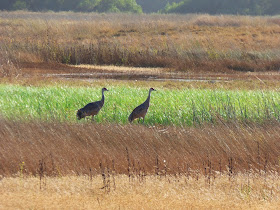 |
| Sandhill Cranes at the San Luis NWR |
 |
| Sandhill Cranes at the San Luis NWR |
The Great Valley is 400 miles long, and around 30-40 miles wide, running from Redding at the north end to Bakersfield in the south. It is amazingly flat, with total relief of only a few hundred feet. Two major river systems, the Sacramento and San Joaquin, provide a richness of water in what would otherwise be desert or near-desert. A huge range of habitats existed here at one time, including short-grass prairies, riparian floodplains, oak woodlands, lakes, and vernal pools. Although agriculture and urban development have co-opted some 95% of the valley floor, there are still pockets of native environments remaining.
 |
| Killdeer at the Merced NWR |
The valley originated as a large shallow sea called a forearc basin along the vast subduction zone that once existed across the entire west coast of North America. The convergent boundary was eventually changed, and the San Andreas transform took its place. The Coast Ranges rose in the last few million years, acting as a rain shadow, and preventing the rivers from finding an easy path to the sea. The Sacramento and San Joaquin rivers flow outward through the Carquinez Strait, but several other rivers, including the Kings, Tulare, and Kern, don't reach the sea. Prior to settlement and diversion of the rivers for agriculture, they ended in large shallow lakes at the south end of the San Joaquin Valley. The lakes are dry today.
 |
| Yellowlegs (Greater?) at the San Luis NWR |
Though so much of the original valley habitat is gone, a few critical wetlands remain and are preserved as a string of National Wildlife Refuges. These refuges are a critical component of the migratory flyway for millions of birds. Some simply pass through, stopping long enough to eat and gather energy for their long journey, but others spend the winter here, and some stay all year.
 |
| California Quail at the San Luis NWR |
Many tourists pass through the Great Valley without a second thought on their way to Lake Tahoe, Yosemite, or Sequoia/Kings Canyon, but at this time of year they are missing an awesome show of the variety and diversity of nature. There is nothing quite like seeing and hearing the spectacle of 10,000 geese taking off all at once. There are hundreds upon hundreds of bird species who spend at least part of the year in the valley, not to mention a rich variety of mammals, reptiles, fish and amphibians. The valley for all its problems can be a fascinating place to spend some time.
 |
| Great Blue Heron at San Luis NWR |
 |
| Northern Shovelnose at the Merced NWR |
We were entranced by the hundreds of Sandhill Cranes arriving by the minute in the setting sun. The video below provides a sense of how it felt...
Don't just pass through the Great Valley on your next trip to California. Check out our valley and find out why we call it "Great". Two places to get information: the headquarters for the San Luis NWRC near Los Banos, and in a few short months, the Great Valley Museum on the west campus of Modesto Junior College.
The title quote comes from Will Durant, and in its entirety reads "Civilization exists by geological consent, subject to change without notice".

I enjoyed hearing the cranes! When I lived in the Black Hills, I'd hear them passing overhead in the fall -- such an eerie sound
ReplyDelete